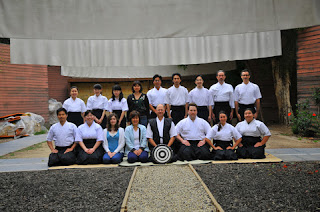Tuesday, May 25, 2010
The Nanka Kyudo Kai
In 1996, the same year we formed the UCI Kyudo Club, Kosaka Sensei had been asked by his long time kyudo sempai to align the Los Angeles Kyudo Kai with an old school of kyudo called Muyoshingetsu-ryu.
In this same year the kyudo groups in The U.S. were forming the American Kyudo Renmei. Though Kosaka Sensei was going to Muyoshingetsu-ryu (we had learned this form and I had been authorized, in fact, pressured, to teach kyudo in this way) I really felt that kyudo was best taught (especially in the beginning) according to the method I had learned at the ANKF/Kyudo USA seminars. Kosaka Sensei and I discussed it; we agreed that Muyoshingetsu-ryu would not be for everyone, and that the ANKF method was needed in Southern California.
The AKR was going to have one Renmei per state, but I really needed to have control of how Southern California was to be run if I was both going to honor Kosaka Sensei, and his wishes, but teach according to ANKF guidelines; so I insisted that we have two in California; it was agreed that our group in Southern California, with its long history, would be 'grandfathered in' as a separate Renmei.
I went to Kosaka Sensei for a name. He named me and my group The Nanka Kyudo Kai. Nanka is the local abbreviation for Southern California. This was to reflect the teaching I was doing at 5 dojo throughout the area (Southbay, East L.A., San Diego, UCI, and West L.A.).
Today I only teach at my one dojo in Pasadena California. Kosaka Sensei kept his Southbay School as Muyoshingetsu-ryu. I've always allowed the other schools to attend my East L.A. dojo (now in Pasadena), but today everyone follows the ANKF form; San Diego was originally Ogasawara-ryu (since I began it before I had studied ANKF) but today Curran Sensei runs it as an ANKF dojo; UCI was my original ANKF only dojo (so it is still run that way); and the West L.A. range has always been, and remains, for all schools to gather there.
Today the other dojo are run by others, and my Nanka is just the dojo in Pasadena and the open practice we host at Rancho Park in West L.A.. We still practice according to the ANKF guidelines in Pasadena; and allow all kyudo-ka form all schools, styles, and renmei to join us at our Sunday practice at Rancho Park.
Please come join us if you are in L.A.
Labels:
Kyudo,
Nanka Kyudo Kai,
Zen Archery
Subscribe to:
Post Comments (Atom)


The Muyo Shingetsu School of Kyudo
ReplyDeleteThe characters for the name “Muyo Shingetsu” translate as the following:
mu = nothing
yo = shadow
shin = spirit/heart/mind
getsu = moon
The Muyo Shingetsu school of kyudo was founded by Master Kenran Umeji in the 1920's, in the town of Himeji, south of Osaka. After Master Umeji's death, his principal disciple, Master Gyo Sagino, headed the school until his own death in 2004, whereupon his grandson Michiya Sagino took over the role. There are about 400–600 practitioners of this style world-wide, with conferences and training sessions held several times a year in Himeji as well as at other dojos in Japan, Italy and the United States.
The basic philosophy of the school is revealed in Life and the Way of the Bow by Master Umeji, of which the following is a small excerpt:
"Life is to realize the unity of the soul and the body. ... The state of existence we are reaching is called kyo: in other words, true life. ... The state of kyo is our way of archery. If we practice this way of archery, then our shooting will become one and the same with our true self that resides in the absolute world. Here there is no distinction between ourselves and others, and we are one with nature. And when we exhaust ourselves absolutely, completely exhausting heaven and earth, then and there we will obtain our true self, where there is no difference between life and death, where we find ourselves serene yet firmly determined. We breathe naturally and are not lost. We are relaxed and our wisdom matures and becomes round. We receive totally and realize what our true self should do. Easily, without hesitation, we can discard the relative life."
Having practiced both styles of Kyudo, what do you find to be the major differences?
ReplyDeleteI have heard that when it comes down to it "Kyudo is Kyudo". What are your thoughts on this?
I agree with the kyudo is kyudo statement. I have studied 5 different styles, and each one may have a emphasis or approach to the practice. But the principles on how to shoot can almost always be aligned to be considered the same teaching.
ReplyDeleteThe biggest difference would be between those schools who approach kyudo from the outside in, and those that use the inside to out approach.
I use both approaches according to the needs of those who are listening, and what I think will work best for them; but I'm still just teaching kyudo. My teaching changes little by what style I teach other than the outside form and some approaches fit some styles better than others. Also I try to fit the teaching style of the person who taught me a style to some degree; though I do, of course, have to teach from my own experience too.